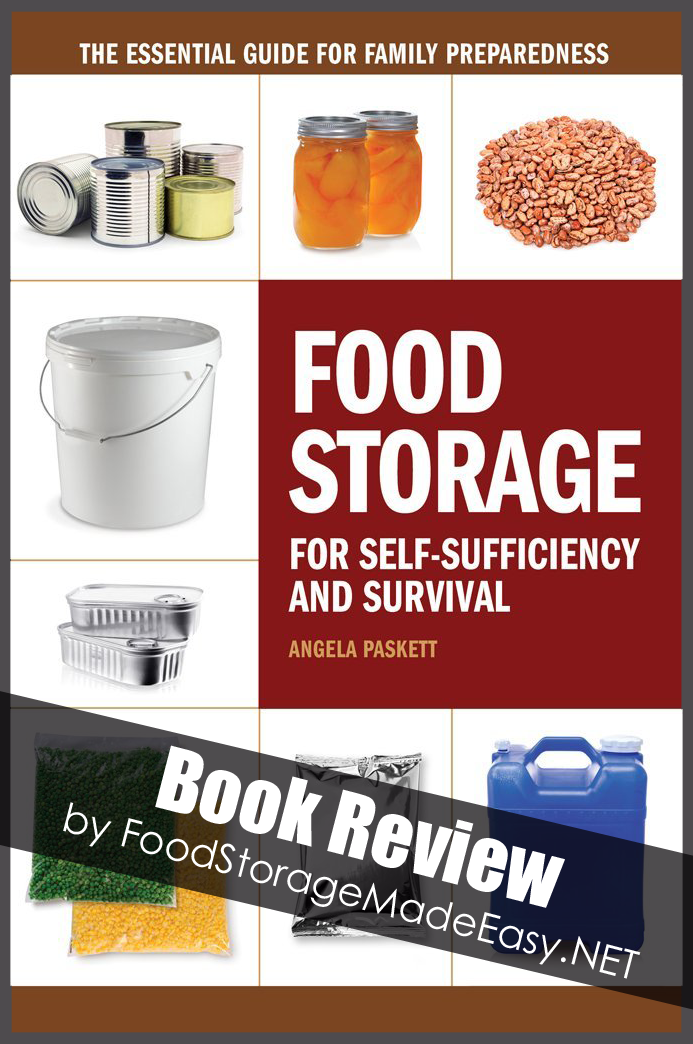Blogging can be a little bit of a lonely world, even though we have tons of food storage friends online. It’s always nice to meet one of our readers or a fellow blogger face to face. We have connected with Angela from Food Storage and Survival and have enjoyed it every time. So when we were given the chance to review her new book Food Storage for Self-Sufficiency and Survival of course we jumped on it! She has very similar ideas about food storage as us and we knew it would be a great read.

The Basics
In Food Storage for Self-Sufficiency and Survival Angela does a great job at taking hard topics and making them feel approachable. Food storage and preparedness are such in depth concepts that it’s easy to feel overwhelmed when you get started and have no idea where to even begin. The first four chapters of the book are perfect for anyone who is brand new at food storage. She covers 72 hour kits, short-term food storage, long-term food storage, and water storage. She goes into a lot of depth while not getting so technical and detailed that you get lost. For people who already have a decent food storage established, you will still find useful tidbits in every chapter. A few of the pop out-sections I loved were:
- Recipe for Homemade Survival Bars
- Cooking on a Dakota Fire Hole
- Sample Menu Lists
- Shelf Life Chart (check out Angela’s Printable Chart for a sneak preview of this)
Preserving and Packaging
The next three chapters focus on how to preserve foods, how to dry pack items you’ve bought, and tips for actually buying the food you will be preserving or packaging up for long term storage. Again, Angela makes these topics feel doable for a beginner, and yet still has good tips for a veteran. For in-depth tutorials with visuals it’s usually easier to watch in a video format (we recommend this canning DVD for beginners). But once you’ve got the hang of it, this book provides a vast amount of helpful references and charts that I’m sure I will refer back to frequently. Some of my favorite parts of this section are:
- Reviews on newer products such as JARbox totes and Tattler Reusable Canning Lids
- Preparation instructions for canning specific fruits and vegetables
- Chart with dehydration times for a variety of foods
- List of seasonal and event sales to know when to buy certain foods at the lowest prices
Advanced Topics
After covering the basics, Food Storage for Self-Sufficiency and Survival goes into some sections that you don’t always see in traditional “food storage” books. She has a chapter on maintaining balance and variety in your diet which includes fun topics like preserving meats, making your own yogurt, and storing sweets. Angela basically takes a look at each of the basic “categories” of food storage and gives lots of ideas for how to mix things up or add to them to help you avoid flavor fatigue in an emergency.
The next section is on sustainable food storage. I love how it is introduced in the book:
Food stored in cans and buckets will eventually run out. Supplementing your stored food with sustainable food sources like gardening, livestock, or hunting will help extend the food supply you have as well as provide food for years to come. Plus it is one of the least expensive and healthiest ways to gather food for your family for everyday eating and storage.
Angela goes into a lot of detail on gardening, harvesting seeds, raising small AND large livestock, hunting and trapping (including what guns/ammo are best), and even discusses wild edibles. This chapter could be a whole book in itself and was a great read for me as I haven’t dived into most of these topics in depth yet.
Organizing and Using Your Food Storage
One of our favorite things is teaching people how to get their food storage OUT of their basements and INTO their kitchens. The last section of Food Storage for Self-Sufficiency and Survival does just that. It first covers a lot of organizational tips which are critical for rotation and for feeling like you have a place for all of that food to go that is accessible to you. The last chapter is all about USING your food. I love that Angela doesn’t just list a bunch of recipes, she actually TEACHES us how to use what we have stored to make regular meals that our family already loves. I love the shelf stable substitutions chart and how she gives two real examples on how to convert a regular family recipe into a “food storage” recipe.
The very end of the book has two pages that cover powerless cooking options. My only complaint about the book is that this section wasn’t long enough! There was so much detail on the other topics and I would have loved to see this topic explored in a similar amount of depth. It was a great brief overview, but I would have been interested to see her take on the pros and cons of each tool listed (similar to how she did it for the small camp stoves in the first chapter). Maybe the book was getting too long 🙂
Don’t forget to check out the appendix that has tons of charts and worksheets to help you with the concepts discussed throughout the book!
Overall I would recommend the book to anyone just getting started, and I think it’s a great reference tool to have on hand for those who are more veteran in the world of preparedness. Like I said, the book is full of great advanced tips and tricks while still maintaining a feeling of being doable for a beginner. Great job Angela!

-Jodi Weiss Schroeder
http://foodstoragemadeeasy.net

